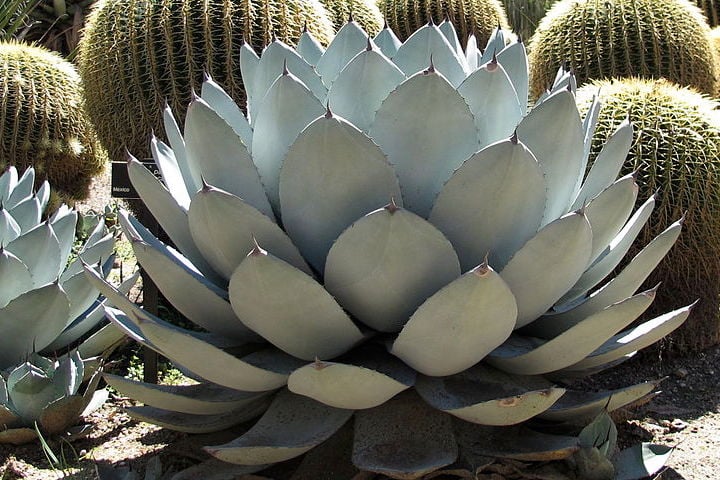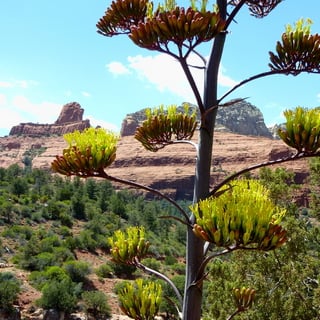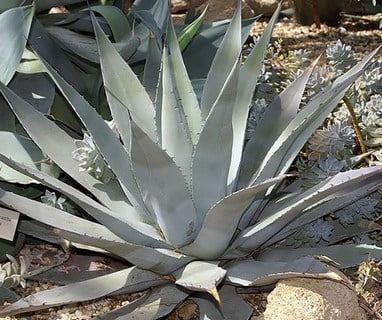Parry’s agave is a beautifully symmetrical agave with silver leaves that make it an eye-catching landscape plant. (But beware of the wicked thorns!) Here’s everything you need to know about planting and taking care of this southwest desert native.

Parry’s agave (Agave parryi) is a distinctive-looking medium-sized agave that is native to parts of the Sonoran and Chihuahuan Deserts.
Its silver-blue leaves tipped form eye-catching rosettes. Leaves are lined with small sharp teeth and have a prominent red-brown tip that warns “do not touch.”
Parry’s agave is as close to “no maintenance” as a plant can be. It grows slowly, doesn’t need pruning, needs minimal water, and doesn’t produce litter.
And at the end of its lifespan it puts out a huge flower stalk that attracts bats, moths, and pollinating insects. Since it readily reproduces by producing offsets called “pups,” you’ll have an endless supply of new plants.
Why I Like This Plant
- Looks stunning all year
- Eye-catching blue-gray leaves
- Extremely hardy, low-maintenance
- Reproduces by pups
- Attracts pollinators when in bloom
Things to Watch Out For
Its leaves are lined with sharp, brown teeth and have long, sharp spines at the tips, up to 1.5″.
Agaves contain compounds that can cause a rash called agave dermatitis in some people.
Optimal Growing Conditions
If you’re thinking of adding a Parry’s agave to your garden, you need to find a suitable place that will keep your plant healthy and looking good… while minimizing maintenance for you.
Here are the key factors to keep in mind.
Temperature
Parry’s agave should be grown in USDA Hardiness Zones 7 – 11. It can take both extreme heat and cold, surviving temperatures down to 15℉.
Sun Exposure
As a southwest desert native, Parry’s agave thrives in full sun but will tolerate some partial shade.
Size and Growth Rate
Parry’s agave is slow growing and ultimately reaches a mature size of 2 feet tall by 2 to 3 feet wide.
Plants generally live to be 12 to 25 years old. At the end of its lifecycle, it will send up an impressive flower stalk and then die. Flower stalks are fast-growing and generally reach a height of 12 feet but can get as tall as 20 feet!

Parry’s agave can be grown in a container, which slows its rate of growth.
Soil
In its native habitat, Parry’s agave grows on rocky slopes. In the garden, it prefers dry, rocky. Good drainage is essential to avoid root rot.
It can be grown in pots but needs excellent drainage. Make sure your pot has adequate drainage holes and use specifically formulated cactus soil.
Other Location Considerations
Due to this plant’s spiky nature, keep it away from guests, children, and pets. It’s not recommended that you grow it near a sidewalk, pool, front door, or anywhere people might brush against it or be tempted to touch it. You can clip the spines to protect people or pets that may come in contact with it, but it still has sharp teeth on its margins.
Parry’s Agave:
The Essentials
| Common Name | Parry’s agave |
| Scientific Name | Agave parryi |
| Origin | Arizona, New Mexico, Texas, Mexico |
| USDA Zones | Zones 7 – 11 |
| Cold Hardiness | To 15℉ |
| Mature Size | 2′ high x 2-3’ wide |
| Growth Rate | Slow |
| Sun Tolerance | Full, part sun |
| Water Needs | Low |
| Pests & Diseases | Root rot if overwatered |
| Cautions | Agave dermatitis, spines |
| Wildlife | Deer resistant |
How to Plant
Dig a hole as deep as and twice as wide as the nursery container. Carefully remove the plant from the container, put it in the hole, and fill with the same native soil you just removed. Press the soil to remove any air pockets.
Never plant deeper than the depth of the root ball which can cause rot. Actually, it’s best to plant an inch or two above soil level to give the plant room to settle and leave room for mulch.
It’s generally recommended that you not add amendments to the soil. However, good drainage is critical, so if your soil drains slowly, amend with coarse sand or small gravel until you have a loose, well-drained mix.
When to Plant
The best time to plant agaves is in April and May. The warm temperatures of spring encourage root development. The second best time is in late summer or early fall when temperatures are still high.
How to Care for Parry’s Agave
Whether you’ve recently planted a Parry’s agave or have an existing plant in your yard, here’s how to take care of it to keep it healthy and looking its best.
How to Water
You’re probably used to giving a plant a good soaking immediately after transplanting, but that isn’t the best practice with agaves.
Counterintuitively, it’s best to not water agaves for one to two weeks after planting. Then use the following schedule as a guide.
| Spring & Fall | Every 3-5 weeks |
| Summer | Every 2-4 weeks |
| Winter | Only if no winter rains |
Plants can survive on rainfall alone once established, but will look their best with some irrigation.
Frequent watering will make an agave grow larger, faster. This might sound like a good thing, but it causes the plant to reach the end of its life sooner.
If you’re growing your agave in a container, use this watering schedule as a guide.
| Spring & Fall | Every 7-10 days |
| Summer | Every 5-7 days |
| Winter | Every 10-14 days |
Should You Fertilize?
There is no need to fertilize Parry’s agave, they get all they need from the surrounding desert soil. Fertilizing can encourage faster growth, which you may or may not want.
If you grow one in a pot, fertilize lightly once a month spring through summer.
Pruning & Propagation
Parry’s agave should not be pruned except to remove dead or damaged lower leaves.
Parry’s agaves are easy to propagate. All you have to do is dig up the offsets, making sure that some root remains intact, and plant them elsewhere in your yard or in pots.
Pests
The agave snout weevil is an insect that can attack any agave, but large agaves like century plant (Agave americana) and Weber’s agave (Agave weberii) are most at risk. However, Agave parryi is on the list of agaves considered susceptible.
Learn how to recognize and prevent this pest, and what steps you should take if you have an infected plant in this article: Agave Weevil: Little Bug, Big Problem.
Plant Lover Facts
Parry’s agave (Agave parryi) is native to Arizona, New Mexico, Texas, and Mexico. It’s named after the American botanist Charles Parry. Dozens of plants are named after him, including Parry pinyon, Parry’s primrose, and Parry’s penstemon.
There’s a lot of taxonomic confusion surrounding this plant, and you may come across other varieties or subspecies when shopping. They vary in size and appearance, but all require the same care.
- Agave parryi ssp. neomexicana
- Agave parryi ssp. parryi
- Agave parryi var. couesii
- Agave parryi var. huachucensis
- Agave parryi var. couseii

The most popular variety grown as a landscape plant is artichoke agave (Agave parryi var. truncata). Its leaves form a tight rosette that resembles an artichoke.
Parry’s agave had many traditional uses. It was an important food source to some Native American tribes who consumed the roots, flower stalks, young leaves, and crowns, and created a fermented drink. The thorns and fibers were used as needle and thread, and dried stalks were used as tool handles.
Did you enjoy this article?
Sign up for our weekly newsletter
where you’ll find more great info on creating &
maintaining a beautiful, carefree desert landscape.
Author Bio
Deane Alban is the creator of Southwest Gardener. She is a science writer with a bachelor’s degree in botany from the University of South Florida. Gardening is her lifelong passion. She’s been gardening in Tucson for over 15 years.

Photo Credits
Megan Hanson, CC BY-SA 2.0, via Wikimedia Commons
David J. Stang, CC BY-SA 4.0, via Wikimedia Commons
